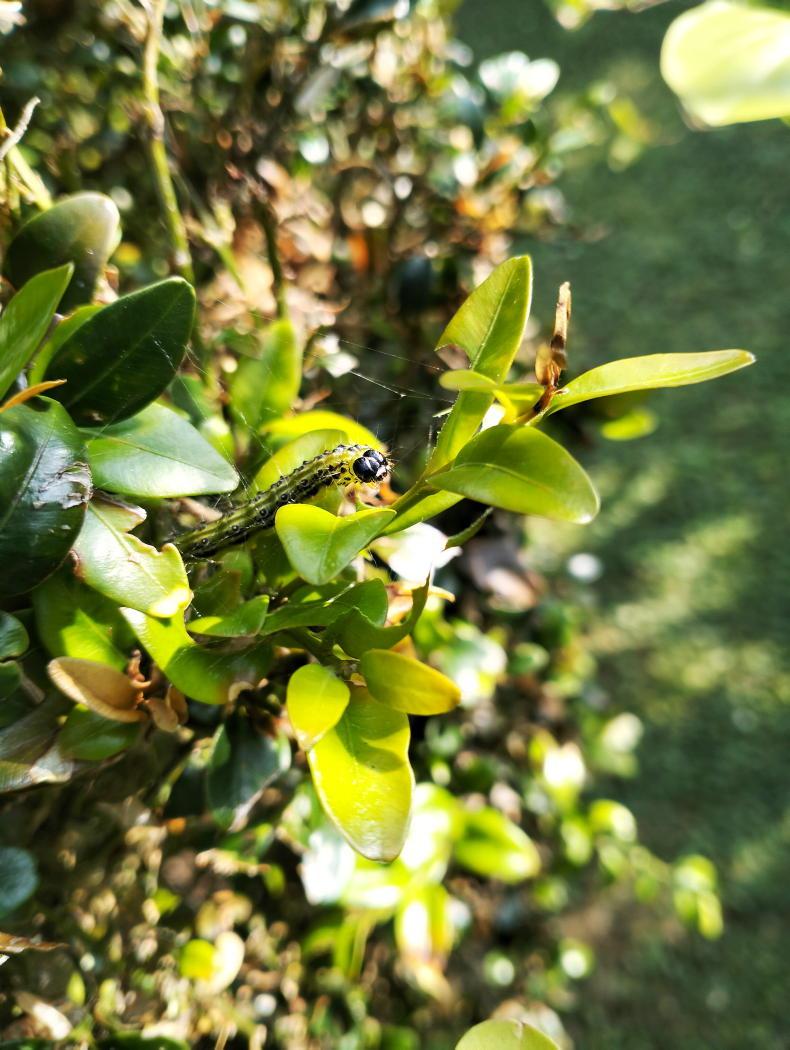MOST equestrian yards and studs have box hedging somewhere. At this time of year the myriad of flower colours cheer my mood and the gentle fragrances wafting as I pass bring my imagination to exotic places. Providing a backdrop to these floral delicacies however are often stout and sturdy hedges. Dark green, different heights, small at the front, tall at the back, like castle walls protecting and sheltering their clan.
Lately though, I noticed a change in these guardians. Beautiful in their own right, these green hedge pillars and boxes will see me through the dark, wet days of winter, when the flowers have gone. At first, it was only one hedge, then I spied more. And more! The elegant hedges have brown patches, exposing the little leaves masticated and coated with sticky threads. This called for further investigation. It didn’t take me long to discover an interesting caterpillar with stripes along its body the colour of sap green and black, munching the leaves of the box tree hedge. He wasn’t alone, however, and I could see how quickly he and his many comrades were consuming the defenceless hedge. In fact, on a quiet evening I could hear them chewing!
Native caterpillars
Cydalima perspectalis or Box Tree Moth was first recorded in Germany in 2006. It has since travelled throughout Europe, being spotted in the Netherlands in 2007 and Hungary in 2011. It even went to the 2014 Winter Olympics, when it was introduced from Italy on a shipment of Buxus sempervirens, which was then planted in Sochi to enhance the Olympic Games. The Box Tree Moth swiftly defoliated the neighbouring Buxus colchica, another member of the Box Hedge family.
Originally from the Far East, this caterpillar is very particular in its tastes. The similar privet hedge Ligustrum ovalifolium seems immune to the Box Tree Caterpillar. Unlike our native caterpillars the offspring of the Box Tree Moth will strip a hedge, feeding voraciously on leaves and stems. It is active between April and October, chewing away until the hedge is spent. Adult moths can travel approximately seven kilometres in search of new box hedging, where one can lay 700 eggs.
The first recorded incidence of the Box Tree Moth in Ireland was in September 2018. Hedges in Dublin’s Rathfarnham and Blackrock were the first to show signs of damage. However, these were not recently planted but well established boundaries. The caterpillars had come in on new, imported stock planted nearby. Importers and growers should be mindful of this threat to diversity.
If you discover Box Tree Moth in your yard or farm topiary, ideally comb through the branches with your hand fork or a similar tool. Shaking the hedge will also dislodge the eggs and caterpillars (they jettison themselves on a silken rope). You’ve got to be careful not to obliterate other, more welcome creatures. For example, while I was shaking out a Buxus sempervirens, a brown stick like caterpillar fell out. Carefully, I placed it on an uneaten Buxus, and identified it as a juvenile Peppered Geometer Moth native to the northern hemisphere. This curious little caterpillar mimics the form and colour of a twig, and is quite harmless and unassuming.
Climate change
Our relatively mild climate, influenced by the great Atlantic on one side and the Jet Stream above gives us the advantage of successfully growing a wide range of plants and trees. But the impact of ‘food miles’ and climate change is starting to challenge us in our own gardens and fields. Insects which should be removed at source are getting trapped in packaging, only to escape, where, unfortunately, they cause a real threat to biodiversity. The Box Tree Moth does not survive our winters but, dormant, protected Box Tree Caterpillars can survive our winters, ready to start the cycle of destruction again.
Like me, you may have been wondering why garden birds are not eating the caterpillars? One reason is the caterpillars are simply so new. Our fauna don’t know what they are. Recent observations from Britain have shown blue tits are investigating this new food source. Jackdaws in particular have started to feast on the Box Tree Caterpillars. And, to the delight of gardeners, jackdaws have been returning to catch further generations. The other day, I noticed somebody else shaking their box tree hedge vigorously. Very surprised, I looked out, and spied a magpie hopping up and down, pulling caterpillars out of their hiding places within the branches!
So, save yourself some toil. Avoid using sprays that may harm our efficient and effective bird friends. Vigilance and persistence will win out. And it’s a handy excuse to sit out enjoying the garden for a bit longer on a summer evening.


 This is a subscriber-only article
This is a subscriber-only article
 It looks like you're browsing in private mode
It looks like you're browsing in private mode









SHARING OPTIONS: